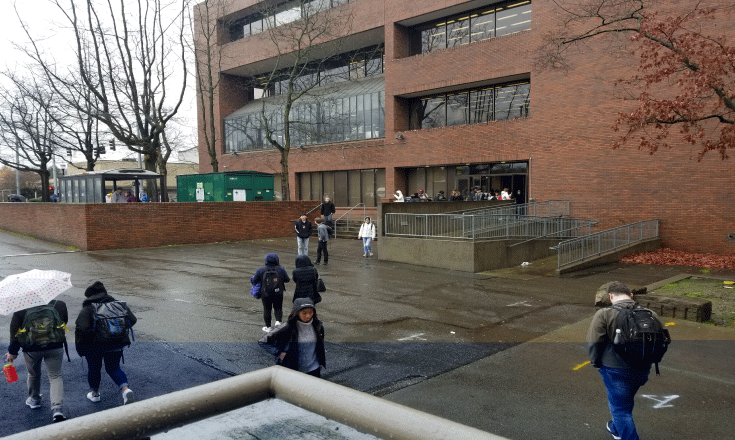
Photo Credit: Tiffany-Ashton Gatsby
Tales of a Non-Traditional Student
Written by Tiffany-Ashton Gatsby, 11/26/2018
Community colleges across the country have long been a welcome home for non-traditional students. Typically, non-traditional students are defined as someone who is over the age of 25 and who has significant responsibilities in work and life. A study conducted by the National Center for Education Statistics from 1995 to 2012 shows the overwhelming majority of non-traditional students come from households whose parents have not achieved a bachelor’s degree, are single parents, work at least part-time when enrolled in school and qualify as low-income. This study also showed the majority of non-traditional students had a high school GPA of 3.0 or higher, are planning on obtaining a degree later on, and if enrolled at the community college level are focusing on work in healthcare. However, the same demographic group enrolled at a four-year college was seeking a degree in business.
At SCC, being a non-traditional student is the norm rather than the exception.
When first enrolling at Seattle Central College, I assumed I was going to be the outlier. I came back to school at the age of 40, and while I’m incredibly comfortable in younger crowds, I was preparing myself for odd looks from professors and ‘grandma’ jokes from other students. I couldn’t have been more wrong. At SCC, being a non-traditional student is the norm rather than the exception. With programs like Senior Tuition Waivers and Running Start and the inability of new high school graduates to afford higher education, the definition of the non-traditional student may be shifting.
I decided to take a ‘warm-up’ class to get back in the swing of things and ready for school. My drawing class had retired people taking art for fun, a high percentage of people in their 30s and a bunch of high school kids in Running Start. I fit right in but assumed that wouldn’t last once I was enrolled in something other than an art class. Once again, with just a few exceptions, I was proven to be incorrect.
Always sitting up front, I felt more pressure to speak up in class when the instructor asked a question. Like I was expected to know the answer due to my seat choice and my age.
The only classes where I was undoubtedly the old lady in the room were my prerequisite English classes. While these courses arguably were still filled with non-traditional students, I had a few more smile lines than some of my classmates. Always sitting up front, I felt more pressure to speak up in class when the instructor asked a question. Like I was expected to know the answer due to my seat choice and my age.
There was also pressure to shut up. I didn’t want to take away from the learning experience of others. I sometimes felt a glare from the instructor. A look that said, “Yes, I know you know the answer to this question.” I fine-tuned the technique to deploy after a question was posed to the class. Count one, two, look over my right shoulder, look over my left shoulder, raise my hand. I’m sure everyone else figured out my routine and knew that if they waited long enough, I’d answer.
I was sure I wasn’t alone in my experiences returning to school. Another returning adult student, Lori Mahieu, sat down to discuss some of her perspectives with me on coming back to school. Motivated by the results of the 2016 election and the desire to stay living in Seattle despite rising rents, she enrolled at SCC to change her career path.
“Since I was a little girl, I’ve always been incredibly interested in civics and our government and our duty as citizens,” said Lori.
“I felt like it was a sign that I needed to follow this path that I’ve wanted since I was very young.”
That statement resonated with me, as a motivating factor for returning to school was a desire to chase the career dreams I’ve had since I was a young child. I had intended on going to medical school, but life happened, as they say. Like many other adult students before me, parenthood and an unexpected career that could provide for a family were driving factors that made it impossible to follow a childhood dream. In my case, a disability proved to be what would ruin my established career while allowing me to return to school to chase a career in medicine, albeit in a slightly different form than I had initially intended.
I was curious to see if Mahieu felt we were at a disadvantage as adult students, “I think that we have a huge advantage as adult students in our understanding of the world,” she said.
“A lot of the things that we learn in the classes, especially at a two-year college level, are often times things that we have come across in our day-to-day lives even though we didn’t think about them in exactly that way. But you have so much life experience to draw on, you know yourself well, you know how you’re going to take to a certain subject. I feel often times I have more clarity on what I need to do.”
Annika Wohlf, a Running Start student, told me, “I really enjoy being in classes that are primarily older students, I find them much more enjoyable to work with. If anything I think fellow Running Start students are far more distracting in class than the older students.”
Admittedly, my mind was a bit blown. I didn’t expect this to be a popular opinion, but after talking to several other younger students, this seemed to be the consensus. The community college experience is welcoming to all, young and old. But will this hold on a four-year university campus filled with traditional students, most of whom just graduated from high school, are privileged enough to have their parents fund their education and don’t even have to work? As of the autumn quarter of 2018, the University of Washington Seattle campus average student is 23 years old, and even the graduate students average under 30 years of age. Something tells me the experience will be drastically different and far less welcoming than Seattle Central, but I guess I’ll have to wait and see…


